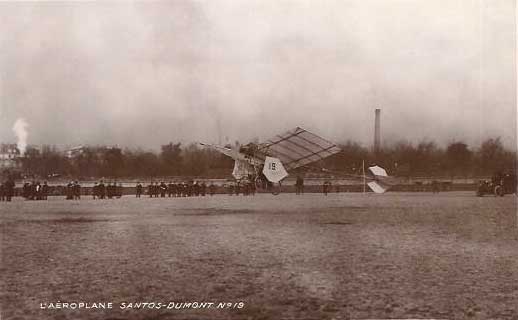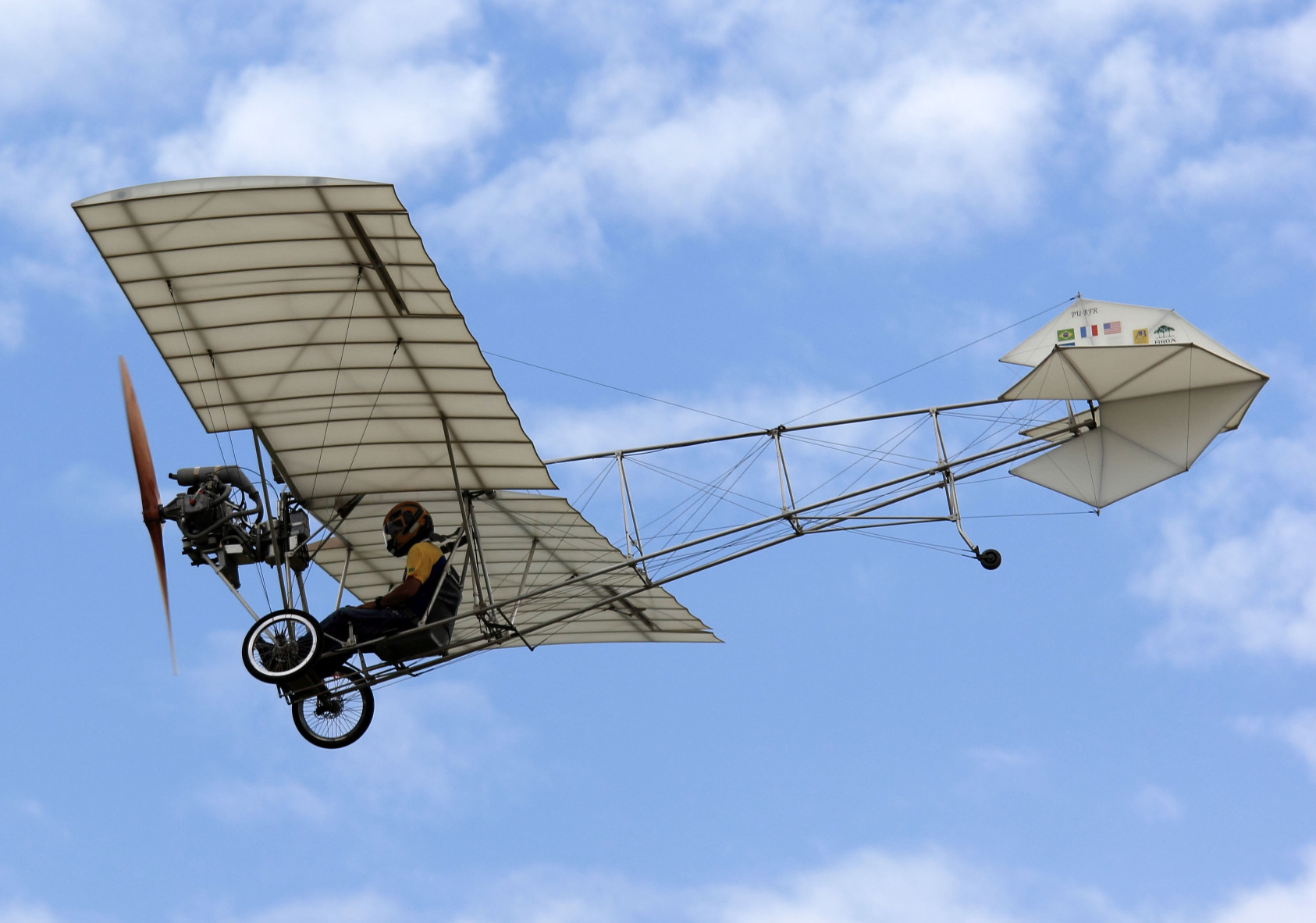Santos-Dumont 19 on:
[Wikipedia]
[Google]
[Amazon]
The Santos-Dumont ''Demoiselle'' was a series of aircraft built in France by world aviation pioneer Alberto Santos-Dumont. They were light-weight monoplanes with a wire-braced wing mounted above an open-framework fuselage built from bamboo. The pilot's seat was below the wing and between the main wheels of the undercarriage. The rear end of the boom carried a tailwheel and a cruciform tail. The name is a synonym for "jeune fille"—young girl or woman—but also the common name in French for a Damselfly.
 The first aircraft of the type was the Santos-Dumont No. 19, which was built to attempt to win the
''Grand Prix d'Aviation offered for a one kilometre closed-circuit flight. Powered by a 15 kW (20 hp) air-cooled Dutheil & Chalmers flat-twin engine mounted on the leading edge of the wing, it had a wingspan of 5.1 m. (16 ft 9 in), was 8 m (26 ft 3 in) long and weighed only 56 kg (123 lb) including fuel. It had a pair of hexagonal rudders below the wing on either side of the pilot, a forward mounted hexagonal elevator in front of the pilot and a cruciform tail which, like the boxkite-style
The first aircraft of the type was the Santos-Dumont No. 19, which was built to attempt to win the
''Grand Prix d'Aviation offered for a one kilometre closed-circuit flight. Powered by a 15 kW (20 hp) air-cooled Dutheil & Chalmers flat-twin engine mounted on the leading edge of the wing, it had a wingspan of 5.1 m. (16 ft 9 in), was 8 m (26 ft 3 in) long and weighed only 56 kg (123 lb) including fuel. It had a pair of hexagonal rudders below the wing on either side of the pilot, a forward mounted hexagonal elevator in front of the pilot and a cruciform tail which, like the boxkite-style  Later, Santos-Dumont made a number of modifications: he repositioned the engine, placing it below the wing in front of the pilot, fitted a different propeller and removed the forward elevator and rudders.
Later, Santos-Dumont made a number of modifications: he repositioned the engine, placing it below the wing in front of the pilot, fitted a different propeller and removed the forward elevator and rudders.
''Flight, 2 October 1909, pp. 603–6 All versions had a pair of lightweight thin-tube radiators mounted under the wing, running the entire meter

No. 19
 The first aircraft of the type was the Santos-Dumont No. 19, which was built to attempt to win the
''Grand Prix d'Aviation offered for a one kilometre closed-circuit flight. Powered by a 15 kW (20 hp) air-cooled Dutheil & Chalmers flat-twin engine mounted on the leading edge of the wing, it had a wingspan of 5.1 m. (16 ft 9 in), was 8 m (26 ft 3 in) long and weighed only 56 kg (123 lb) including fuel. It had a pair of hexagonal rudders below the wing on either side of the pilot, a forward mounted hexagonal elevator in front of the pilot and a cruciform tail which, like the boxkite-style
The first aircraft of the type was the Santos-Dumont No. 19, which was built to attempt to win the
''Grand Prix d'Aviation offered for a one kilometre closed-circuit flight. Powered by a 15 kW (20 hp) air-cooled Dutheil & Chalmers flat-twin engine mounted on the leading edge of the wing, it had a wingspan of 5.1 m. (16 ft 9 in), was 8 m (26 ft 3 in) long and weighed only 56 kg (123 lb) including fuel. It had a pair of hexagonal rudders below the wing on either side of the pilot, a forward mounted hexagonal elevator in front of the pilot and a cruciform tail which, like the boxkite-style canard
Canard is French for duck, a type of aquatic bird.
Canard may also refer to:
Aviation
*Canard (aeronautics), a small wing in front of an aircraft's main wing
* Aviafiber Canard 2FL, a single seat recreational aircraft of canard design
* Blé ...
surfaces on the earlier 14-bis
The ''14-bis'' (french: Quatorze-bis), (), also known as ("bird of prey" in French), was a pioneer era, canard-style biplane designed and built by Brazilian aviation pioneer Alberto Santos-Dumont. In 1906, near Paris, the ''14-bis'' made a m ...
biplane of 1906, pivoted on a universal joint to function both as elevator and rudder mounted at the end of a substantial single boom. There was no provision for lateral control. The undercarriage consisted of a pair of wheels in front of the pilot and a third behind, supplemented by a tailskid.
Santos-Dumont made three flights on 17 November 1907 at Issy-les-Moulineaux.
 Later, Santos-Dumont made a number of modifications: he repositioned the engine, placing it below the wing in front of the pilot, fitted a different propeller and removed the forward elevator and rudders.
Later, Santos-Dumont made a number of modifications: he repositioned the engine, placing it below the wing in front of the pilot, fitted a different propeller and removed the forward elevator and rudders.
No. 20
Santos-Dumont's next aircraft, the Demoiselle No. 20, was first flown with an 18 kW (24-hp) Dutheil et Chalmers later replaced by a 22 kW (30 hp) Darracq-built liquid-cooled opposed twin engine of approximately 3.2-litre displacement. The fuselage consisted of three bamboo tubes forming the primarylongeron
In engineering, a longeron and stringer is the load-bearing component of a framework.
The term is commonly used in connection with aircraft fuselages and automobile chassis. Longerons are used in conjunction with stringers to form structural ...
s, of about 5 cm (2 in) diameter, connected by oval steel tubes. For ease of transportation the bamboo tubes were divided into two sections, joined together by brass sockets. The parallel-chord wings had two spars made of ash
Ash or ashes are the solid remnants of fires. Specifically, ''ash'' refers to all non-aqueous, non- gaseous residues that remain after something burns. In analytical chemistry, to analyse the mineral and metal content of chemical samples, ash ...
and bamboo rib
In vertebrate anatomy, ribs ( la, costae) are the long curved bones which form the rib cage, part of the axial skeleton. In most tetrapods, ribs surround the chest, enabling the lungs to expand and thus facilitate breathing by expanding the ches ...
s Santos-Dumont "Demoiselle"''Flight, 2 October 1909, pp. 603–6 All versions had a pair of lightweight thin-tube radiators mounted under the wing, running the entire meter
chord
Chord may refer to:
* Chord (music), an aggregate of musical pitches sounded simultaneously
** Guitar chord a chord played on a guitar, which has a particular tuning
* Chord (geometry), a line segment joining two points on a curve
* Chord ( ...
of the wing. It used wing warping for lateral control, operated from a transverse-pivoting joystick that would fit into a long, vertical pocket added to the jacket's back that the pilot would wear to fly the aircraft, "leaning into the turn" as either a bicycle rider would do for higher-velocity turns; or as Glenn Curtiss did with the transverse "rocking-cradle armrest" apparatus on the AEA June Bug in 1908. A similar system was used by Santos-Dumont in November 1906 to likewise operate the interplane ailerons on the final version of his ''Quatorze-bis'' pioneering canard biplane. The initial #20 Demoiselle's wing-warping arrangement also possessed control cabling that only pulled down alternately on the outer section of the rear wing spar with no "upwards" warp capability.
The Demoiselle was the last aircraft built by Santos-Dumont. He performed flights with it in Paris, and made trips to nearby places. Flights were continued at various times through 1909, including a cross-country flight with stages of about 8 km (5 mi) from St. Cyr to Buc on 13 September 1909, returning the following day, and another on 17 September 1909 of 18 km in 16 min. The aircraft was exhibited on the Clément-Bayard stand at the Paris Aéro Salon in October 1909 and it was announced that a production run of 100 aircraft was planned. However, only 50 were actually built, of which only 15 were sold, at a price of 7,500 francs for each airframe.. It was offered with a choice of three engines: Clement 20 hp; Wright 4-cyl 30 hp (Clement-Bayard had the license to manufacture Wright engines); and Clement-Bayard 40 hp designed by Pierre Clerget. It achieved 120 km/h.
The French pioneer aviator Roland Garros learned to fly in a Demoiselle at a flight school established by Clement Bayard, and later flew one at Belmont Park
Belmont Park is a major thoroughbred horse racing facility in the northeastern United States, located in Elmont, New York, just east of the New York City limits. It was opened on May 4, 1905.
It is operated by the non-profit New York Racin ...
, New York
New York most commonly refers to:
* New York City, the most populous city in the United States, located in the state of New York
* New York (state), a state in the northeastern United States
New York may also refer to:
Film and television
* '' ...
in 1910. The June 1910 edition of '' Popular Mechanics'' published drawings of the Demoiselle and wrote "This machine is better than any other which has ever been built, for those who wish to reach results with the least possible expense and with a minimum of experimenting." American companies sold drawings and parts of Demoiselle for several years thereafter. Santos-Dumont was so enthusiastic about aviation that he released the drawings of Demoiselle for nothing, thinking that aviation would be the cause of a new prosperous era for mankind. The airplane received 300 copies across Europe and USA. An example of a Demoiselle with a Darracq engine is preserved in the '' Musée de l'Air et de l'Espace''. A flyable replica was built by Personal Plane Services Ltd for the 1965 film ''Those Magnificent Men in Their Flying Machines
''Those Magnificent Men in their Flying Machines; Or, How I Flew from London to Paris in 25 Hours and 11 Minutes'' is a 1965 British period comedy film that satirizes the early years of aviation. Directed and co-written by Ken Annakin, the film ...
'' and others have been built since then. Examples are on display at the Le Bourget Paris Air and Space Museum, The Brooklands Museum in Weybridge, Surrey, England, The Old Rhinebeck Aerodrome in Red Hook, New York and others.
Specifications (No. 20)

References
Sources
* * * * * *External links
{{Santos-Dumont aircraft Demoiselle 1900s French experimental aircraft Aircraft first flown in 1907 1910s French sport aircraft Ultralight aircraft High-wing aircraft Single-engined tractor aircraft